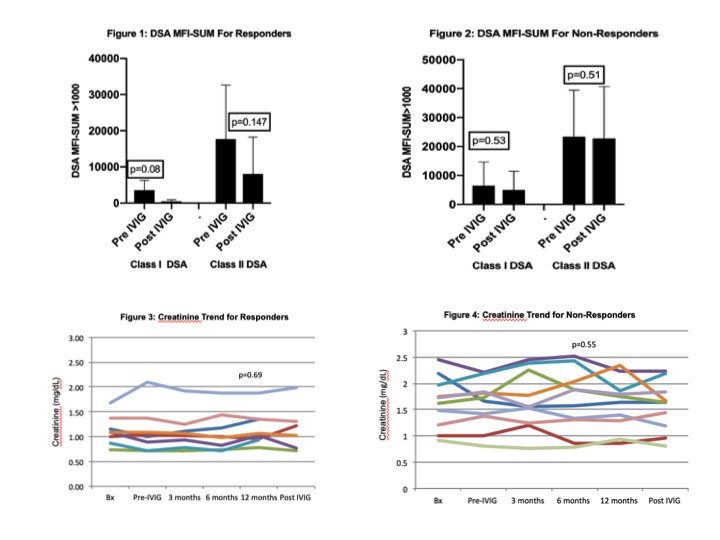Reduction of Circulating DSA: Does It Affect Histology?
1Nephrology, New York Presbyterian Weill Cornell, New York, NY, 2New York Presbyterian Weill Cornell, New York, NY, 3Terasaki Research Institute, Los Angeles, CA
Meeting: 2019 American Transplant Congress
Abstract number: B175
Keywords: Antibodies, Histology, IVIG
Session Information
Session Name: Poster Session B: Kidney Immunosuppression: Desensitization
Session Type: Poster Session
Date: Sunday, June 2, 2019
Session Time: 6:00pm-7:00pm
 Presentation Time: 6:00pm-7:00pm
Presentation Time: 6:00pm-7:00pm
Location: Hall C & D
*Purpose: De novo donor specific antibodies (dnDSA) are reported in 13-30% of kidney transplant recipients. dnDSA has been associated with antibody mediated rejection (AMR) and shortened kidney graft survival. IVIG therapy has been used for the treatment of AMR. IVIG can modulate the B Cell response resulting in decreased production of dnDSA. In this pilot study, we evaluated changes in DSA, kidney function and histology of kidney grafts following IVIG therapy for dnDSA.
*Methods: We prospectively enrolled 19 patients who presented with dnDSA following kidney transplantation. All subjects received IVIG(1g/kg) every two weeks for 6 months and underwent kidney biopsy pre and post IVIG therapy. All subjects were followed monthly for standard of care labs.Of the 19 enrolled in this study, 8 patients achieved a ≥50% reduction in dnDSA (Responders) by one-year after starting IVIG treatment while the remaining 11 did not (Non-Responders). We compared the pre and post IVIG treatment parameters in each group.
*Results: The study cohort consisted of 42% female, 37% with African ancestry and 37% with deceased donor grafts. The median age was 47. Figures 1&2 demonstrate a significant reduction in Class I and II DSA MFI-Sum in the Responders while there was no significant change in the Non-Responders. Figures 3&4 demonstrate that there was no significant change in serum creatinine over time in both groups. However, the serum creatinine levels at baseline were much lower for the Responders compared to the Non-Responders (p=0.02). Figures 5&6 demonstrate that the Banff scores were not significantly different between pre and post IVIG in both groups except for a slightly higher proportion of CG (chronic glomerulopathy) score in the Non-Responders at one-year post IVIG (p=0.04).
*Conclusions: Our study demonstrated that despite a ≥50%reduction in DSA, there was no significant difference in the renal function and kidney histology following IVIG therapy. Whether the Responders will have improved long-term survival as compared to Non-Responders remains to be seen. Given the lack of the changes in the Banff scores, we believe there is a need to develop molecular biomarkers that predict response or lack of response to therapy.
To cite this abstract in AMA style:
Gupta M, Edusei E, Tsai S, Magruder M, Lee J, Lee J, Hartono C, Muthukumar T, Everly M, Dadhania D. Reduction of Circulating DSA: Does It Affect Histology? [abstract]. Am J Transplant. 2019; 19 (suppl 3). https://atcmeetingabstracts.com/abstract/reduction-of-circulating-dsa-does-it-affect-histology/. Accessed December 19, 2025.« Back to 2019 American Transplant Congress


